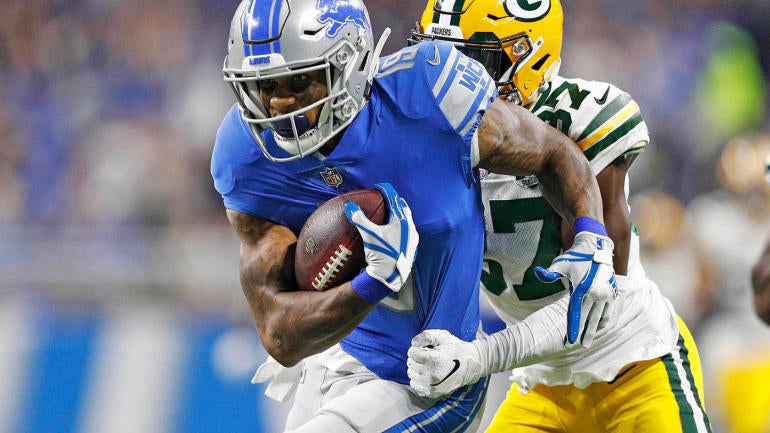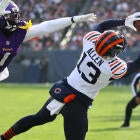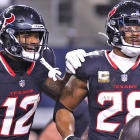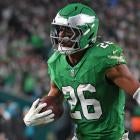
As NFL teams move to offensive systems that use running backs and tight ends as mismatches in the passing game, wide receivers as a whole are seeing their target share get spread a little thin. It has created a landscape where replacing a wideout who's hurt or grossly under performing with someone off the waiver wire won't exactly crush you as it would at running back or tight end. At least 49 wide receivers have averaged at least 10 PPR points per game in four of the past five seasons -- and only 11 wide receivers total have averaged 20-plus PPR points.
This doesn't mean you should wait forever to start taking wide receivers, though.
Your strategy for drafting wideouts should be based on how many you need to start each week and what your scoring system is. The more wide receivers you can start, and the more points you get for receptions, the more likely you'll want to target them.
And if you're not the risky type, wide receivers are a safer bet in Fantasy compared to running backs because they don't get as hurt as frequently. They also have a built-in advantage in leagues where catches count. But there's depth to the position that's better than any other. The best ones are impossible to seamlessly replace, but once you get past the first five tiers, it's not crazy to say that expectations are essentially the same for everyone.
No matter the round, there will always be wideouts worth taking. So the recommendation is to not prioritize any specific strategy for wide receivers and instead bake them into your roster around your approach for taking running backs, quarterbacks and tight ends. Obviously, if you chase wide receivers early, you won't mind settling on lesser talent at other positions. That works for the best in full PPR, and especially if you can start at least three wideouts each week.
If you really want to feel secure, simply pick enough wide receivers from the first five tiers to cover your starting lineup requirements, then grab another two (maybe three) who have as much upside as possible to break out early on in the year. Many of them are in Tier 7.
It's common sense that the wide receivers with high target volume will go early, but even the ones who can average 7.5 per game can finish with at least 120 in a season. Once those guys are gone, the pass catchers with 6.3 targets per game upside will go next since that average comes out to 100 per year. Faster wide receivers are always preferred, as are wideouts who play with accurate, strong-armed quarterbacks. That's why you'll see No. 2 guys like DK Metcalf and Calvin Ridley ranked ahead of No. 1s such as Julian Edelman or Brandin Cooks.
This is all reflected in the tiers, so consider using them to choose a wide receiver when the talent in the highest remaining tier is dwindling. And don't sweat it if you whiff on one because you should be able to find someone who can give you decent production off the waiver wire once the season starts.
On Wednesday's Fantasy Football Today podcast, we discussed the wide receivers in depth. Follow all our podcasts and subscribe here.
Here are the tiers:
M. Thomas
NO
Michael Thomas
NO
|
D. Adams
NYJ
Davante Adams
NYJ
|
J. Jones
PHI
Julio Jones
PHI
|
T. Hill
MIA
Tyreek Hill
MIA
|
D. Hopkins
KC
DeAndre Hopkins
KC
|
C. Godwin
TB
Chris Godwin
TB
|
C. Kupp
LAR
Cooper Kupp
LAR
|
K. Golladay
NYG
Kenny Golladay
NYG
|
C. Ridley
TEN
Calvin Ridley
TEN
|
T. Lockett
SEA
Tyler Lockett
SEA
|
M. Evans
TB
Mike Evans
TB
|
A. Thielen
CAR
Adam Thielen
CAR
|
R. Woods
HOU
Robert Woods
HOU
|
A. Robinson
DET
Allen Robinson
DET
|
A. Brown
PHI
A.J. Brown
PHI
|
A. Cooper
BUF
Amari Cooper
BUF
|
T. McLaurin
WAS
Terry McLaurin
WAS
|
D. Metcalf
SEA
DK Metcalf
SEA
|
C. Sutton
DEN
Courtland Sutton
DEN
|
K. Allen
CHI
Keenan Allen
CHI
|
O. Beckham Jr.
MIA
Odell Beckham Jr.
MIA
|
T. Hilton
DAL
T.Y. Hilton
DAL
|
S. Diggs
HOU
Stefon Diggs
HOU
|
A. Green
ARI
A.J. Green
ARI
|
D. Parker
PHI
DeVante Parker
PHI
|
T. Boyd
TEN
Tyler Boyd
TEN
|
J. Landry
NO
Jarvis Landry
NO
|
B. Cooks
DAL
Brandin Cooks
DAL
|
M. Brown
KC
Marquise Brown
KC
|
M. Jones
DET
Marvin Jones
DET
|
D. Slayton
NYG
Darius Slayton
NYG
|
S. Shepard
TB
Sterling Shepard
TB
|
D. Johnson
BAL
Diontae Johnson
BAL
|
J. Edelman
NE
Julian Edelman
NE
|
J. Reagor
LAC
Jalen Reagor
LAC
|
J. Jeudy
CLE
Jerry Jeudy
CLE
|
C. Lamb
DAL
CeeDee Lamb
DAL
|
M. Gallup
LV
Michael Gallup
LV
|
W. Fuller
MIA
Will Fuller
MIA
|
J. Crowder
WAS
Jamison Crowder
WAS
|
H. Ruggs III
LV
Henry Ruggs III
LV
|
E. Sanders
BUF
Emmanuel Sanders
BUF
|
A. Miller
BAL
Anthony Miller
BAL
|
A. Lazard
NYJ
Allen Lazard
NYJ
|
C. Kirk
JAC
Christian Kirk
JAC
|
R. Chosen
MIA
Robbie Chosen
MIA
|
J. Jefferson
MIN
Justin Jefferson
MIN
|
M. Pittman
IND
Michael Pittman
IND
|
D. Jackson
BAL
DeSean Jackson
BAL
|
S. Sims
HOU
Steven Sims
HOU
|
J. Brown
BUF
John Brown
BUF
|
D. Samuel
SF
Deebo Samuel
SF
|
L. Shenault Jr.
SEA
Laviska Shenault Jr.
SEA
|
M. Williams
PIT
Mike Williams
PIT
|
B. Perriman
IND
Breshad Perriman
IND
|
N. Harry
SEA
N'Keal Harry
SEA
|
P. Williams
CAR
Preston Williams
CAR
|
S. Watkins
BAL
Sammy Watkins
BAL
|
M. Hardman
KC
Mecole Hardman
KC
|
L. Fitzgerald
ARI
Larry Fitzgerald
ARI
|
B. Aiyuk
SF
Brandon Aiyuk
SF
|
T. Higgins
CIN
Tee Higgins
CIN
|
G. Tate
TEN
Golden Tate
TEN
|
R. Cobb
NYJ
Randall Cobb
NYJ
|
C. Beasley
NYG
Cole Beasley
NYG
|
P. Campbell
PHI
Parris Campbell
PHI
|
D. Mims
JAC
Denzel Mims
JAC
|
A. Jeffery
PHI
Alshon Jeffery
PHI
|
M. Thomas
NO
Michael Thomas
NO
|
D. Adams
NYJ
Davante Adams
NYJ
|
T. Hill
MIA
Tyreek Hill
MIA
|
J. Jones
PHI
Julio Jones
PHI
|
D. Hopkins
KC
DeAndre Hopkins
KC
|
C. Godwin
TB
Chris Godwin
TB
|
C. Kupp
LAR
Cooper Kupp
LAR
|
K. Golladay
NYG
Kenny Golladay
NYG
|
C. Ridley
TEN
Calvin Ridley
TEN
|
T. Lockett
SEA
Tyler Lockett
SEA
|
M. Evans
TB
Mike Evans
TB
|
A. Thielen
CAR
Adam Thielen
CAR
|
R. Woods
HOU
Robert Woods
HOU
|
A. Brown
PHI
A.J. Brown
PHI
|
A. Robinson
DET
Allen Robinson
DET
|
D. Metcalf
SEA
DK Metcalf
SEA
|
A. Cooper
BUF
Amari Cooper
BUF
|
T. McLaurin
WAS
Terry McLaurin
WAS
|
O. Beckham Jr.
MIA
Odell Beckham Jr.
MIA
|
C. Sutton
DEN
Courtland Sutton
DEN
|
K. Allen
CHI
Keenan Allen
CHI
|
T. Hilton
DAL
T.Y. Hilton
DAL
|
S. Diggs
HOU
Stefon Diggs
HOU
|
A. Green
ARI
A.J. Green
ARI
|
D. Parker
PHI
DeVante Parker
PHI
|
B. Cooks
DAL
Brandin Cooks
DAL
|
M. Brown
KC
Marquise Brown
KC
|
T. Boyd
TEN
Tyler Boyd
TEN
|
J. Landry
NO
Jarvis Landry
NO
|
D. Slayton
NYG
Darius Slayton
NYG
|
D. Johnson
BAL
Diontae Johnson
BAL
|
W. Fuller
MIA
Will Fuller
MIA
|
J. Reagor
LAC
Jalen Reagor
LAC
|
J. Jeudy
CLE
Jerry Jeudy
CLE
|
C. Lamb
DAL
CeeDee Lamb
DAL
|
M. Gallup
LV
Michael Gallup
LV
|
M. Jones
DET
Marvin Jones
DET
|
H. Ruggs III
LV
Henry Ruggs III
LV
|
J. Edelman
NE
Julian Edelman
NE
|
A. Lazard
NYJ
Allen Lazard
NYJ
|
S. Shepard
TB
Sterling Shepard
TB
|
A. Miller
BAL
Anthony Miller
BAL
|
E. Sanders
BUF
Emmanuel Sanders
BUF
|
C. Kirk
JAC
Christian Kirk
JAC
|
M. Pittman
IND
Michael Pittman
IND
|
R. Chosen
MIA
Robbie Chosen
MIA
|
J. Jefferson
MIN
Justin Jefferson
MIN
|
B. Perriman
IND
Breshad Perriman
IND
|
M. Williams
PIT
Mike Williams
PIT
|
D. Jackson
BAL
DeSean Jackson
BAL
|
S. Sims
HOU
Steven Sims
HOU
|
J. Brown
BUF
John Brown
BUF
|
D. Samuel
SF
Deebo Samuel
SF
|
L. Shenault Jr.
SEA
Laviska Shenault Jr.
SEA
|
N. Harry
SEA
N'Keal Harry
SEA
|
P. Williams
CAR
Preston Williams
CAR
|
B. Aiyuk
SF
Brandon Aiyuk
SF
|
J. Crowder
WAS
Jamison Crowder
WAS
|
M. Hardman
KC
Mecole Hardman
KC
|
S. Watkins
BAL
Sammy Watkins
BAL
|
L. Fitzgerald
ARI
Larry Fitzgerald
ARI
|
















